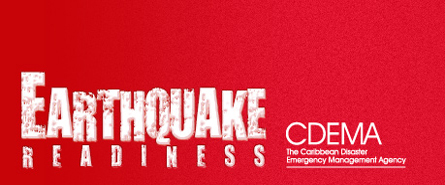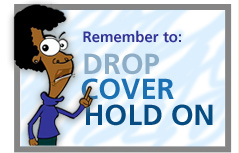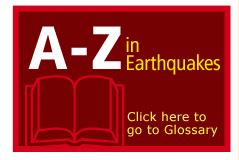|
Stay as safe as possible during an earthquake. Be aware that some earthquakes are actually foreshocks and a larger earthquake might occur. Minimize your movements to a few steps to a nearby safe place and stay indoors until the shaking has stopped and you are sure exiting is safe.
It is important to take quick action to be safe when the ground first starts to shake.
Don't wait until you're certain an earthquake is actually occurring.
At the first sign of the earth shaking, if you are in a building, stay inside and away from windows.
Drop, Cover, and Hold on.
DROP under a heavy desk or table,
COVER your head and torso, and
HOLD ON to the furniture. If you can't get under something strong, go to an interior wall and sit with your bottom and feet flat on the floor and protect your head. If you are outside, go to an open area.
Stay away from the kitchen. The kitchen is the highest hazard area in the home. There may be moving appliances and flying dishes. There may be gas or water pipes leaking. This may lead to fire or flooding.
- Don't panic, try to remain calm and reassure others.
- Protect head and face
- Do not rush for exits. Stairways may be broken and jammed with people.
- Do not try to use your telephone/cell phones for the first 90 minutes after an earthquake, except for serious medical or fire emergency, or if victims are trapped. You could tie up the lines needed for emergency response.
If you use a wheelchair:
- Remain in the chair
- Try to avoid falling objects
back to top
If indoors:
- Drop, Cover, and Hold On. Take cover under a sturdy desk, table, bench or bed or against an inside wall and hold on. If there isn't a table or desk near you, cover your face and head with your arms and crouch in an inside corner of the building.
- If you are in bed, stay there. Hold on and protect your head with a pillow, unless you are under a heavy light fixture that could fall. In that case, move to the nearest safe place.
- If you are in the kitchen, quickly turn off the stove and take cover at the first sign of shaking.
- If you are in a crowded public place, do not rush for the doorways. Others will have the same idea and trampling may occur.
- If you are in a store or shop move away from display shelves containing bottles, cans, or other objects that may fall.
- If you are in a high-rise building, stay in the building on the same floor. Evacuation may not be necessary. Do not use elevators as power may fail.
- If you are at school, Drop, Cover, and Hold ON. Remain in place until the shaking stops. COUNT ALOUD to 60 (earthquakes rarely last longer than 60 seconds and counting is calming)
- If you are in the school walkways, stairways and other areas where no cover is available, move to an interior wall; kneel with back to wall; place head close to knees; clasp hands behind neck; and cover side of head with arms.
- If you are in the library, move away from where books and bookshelves may fall and take cover. Stay inside, usually the most dangerous place is just outside where building debris may fall; exit only after the shaking has stopped.
- If you are in the science laboratories, extinguish all burners, if possible, before taking cover; stay away from hazardous chemicals that may spill.
- Don't try to run out of the building. Stay inside until shaking stops and it is safe to go outside. Most injuries during earthquakes occur when people are hit by falling objects when entering into or exiting from buildings.
- Move away from outer walls, windows, glass doors, heavy mirrors, pictures, bookcases, hanging plants and heavy objects
- Watch for falling plaster, bricks, lighting fixtures and other objects
- Do not use candles, matches, or other open flame either during or after the tremor because of possible gas leaks.
- Be aware that the electricity may go out or the sprinkler systems or fire alarms may turn on.
- Never take shelter by standing in external doorways. Shelter in internal doorways only if there is no other option for protective shelter such as a table or a desk.
If outdoors:
- Stay there unless it is unsafe.
- Move away from buildings, trees, streetlights, and utility wires.
- Assume the crouch position and protect your head and face with your arms until the shaking stops.
If you are in a vehicle:
- Pull over to the side of the road (to keep the road clear for emergency vehicles), and stop as quickly as safety permits.
- Safely bring the vehicle to a stop away from electricity poles and overhead wires.
- Don't stop on a bridge or close to buildings from which debris may fall.
- Avoid stopping near or under trees, overpasses, and utility wires.
- Stay inside your vehicle.
- Proceed cautiously once the earthquake has stopped, watching for road and bridge damage, fallen or falling objects or downed electric wires.
What about the "Triangle of Life"?
The widely circulated "Triangle of Life" theory (which claims it is safer to curl up next to a desk or bed rather than to go under it) has NOT been scientifically tested, and the Seismic Research Centre does NOT recommend this practice. READ MORE
back to top
|













